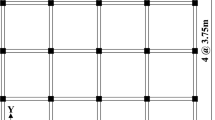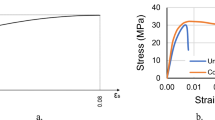Abstract
In order to give the reasonable width of seismic gaps to prevent the structural pounding during ground motions, the maximum relative displacement of adjacent structures is studied in this paper. The factors that may have effects on the maximum relative displacement are discussed. As for multi-degree-of-freedom (MDOF) systems, they can be equivalent to single-degree-of-freedom (SDOF) systems with the influences of high modes neglected. The results show that the period ratio, height ratio and peak ground acceleration are the main factors that have great effects on the maximum relative displacement of adjacent structures. The maximum relative displacement of MDOF systems can be obtained from calculating the maximum relative displacement of the equivalent SDOF systems.
Similar content being viewed by others
References
Bertero Vitelmo V. Observations on structural pounding[ C]. In: Proceedings of the International Conference of Mexico Earthquakes-1985: Factors Involved and Lessons Learned. Mexico City, Mexico, 1986. 264–278.
Kasai Kazuhiko, Maison Bruce F. Building pounding damage during the 1989 Loma Prieta earthquake[J]. Engineering Structures, 1997, 19(3): 195–207.
Civil and Structural Groups of Tsinghua University, Southwest Jiaotong University and Beijing Jiaotong University. Analysis on seismic damage of buildings in the Wenchuan earthquake[J]. Journal of Building Structures, 2008, 29(4): 1–9 (in Chinese).
Wang Yayong. Lessons learnt from building damages in the Wenchuan earthquake: Three earthquake performance objectives and basic requirements for seismic design of buildings[J]. Journal of Building Structures, 2008, 29(4): 26–33 (in Chinese).
Maison Bruce F, Kasai Kazuhiko. Analysis for a type of structural pounding[J]. Journal of Structural Engineering, 1990, 116(4): 957–977.
Papadrakakis Manolis, Mouzakis Harris P. Earthquake simulator testing of pounding between adjacent buildings[J]. Earthquake Engineering and Structural Dynamics, 1995, 24(6): 811–834.
Leibovich E, Rutenberg A, Yankelevsky D Z. On eccentric seismic pounding of symmetric buildings[J]. Earthquake Engineering and Structural Dynamics, 1996, 25(3): 219–233.
Kasai Kazuhiko, Jagiasi Anil R, Jeng Van. Inelastic vibration phase theory for seismic pounding mitigation[J]. Journal of Structural Engineering, 1996, 122(10): 1136–1146.
Lin Jeng-Hsiang, Weng Cheng-Chiang. Probability analysis of seismic pounding of adjacent buildings[J]. Earthquake Engineering and Structural Dynamics, 2001, 30(10): 1539–1557.
Song Tianqi. Research on the problems related to “Code for Aseismic Design of Buildings”(GB 50011-2001)[J]. Industrial Construction, 2005, 35(8): 110–113, 116 (in Chinese).
Karayannis Chris G, Favvata Maria J. Inter-story pounding between multistory reinforced concrete structures[J]. Structural Engineering and Mechanics, 2005, 20(5): 505–526.
Jankowski Robert. Impact force spectrum for damage assessment of earthquake-induced structural pounding[J]. Key Engineering Materials, 2005, 293/294: 711–718.
Jankowski Robert. Pounding force response spectrum under earthquake excitation[J]. Engineering Structures, 2006, 28(8): 1149–1161.
Muthukumar Susendar, DesRoches Reginald. A Hertz contact model with non-linear damping for pounding simulation[ J]. Earthquake Engineering and Structural Dynamics, 2006, 35(7): 811–828.
Rezavandi A, Moghadam A S. Experimental and numerical study on pounding effects and mitigation techniques for adjacent structures[J]. Advances in Structural Engineering, 2007, 10(2): 121–134.
Author information
Authors and Affiliations
Corresponding author
Additional information
Supported by the State Key Program of National Natural Science Foundation of China (No. 50938008) and the Fundamental Research Funds for Central Universities (No. 2012JBM077).
LU Mingqi, born in 1978, male, Dr, lecturer.
Rights and permissions
About this article
Cite this article
Lu, M., Yang, Q. & Yang, N. Maximum relative displacement of adjacent buildings during ground motions. Trans. Tianjin Univ. 18, 366–371 (2012). https://doi.org/10.1007/s12209-012-1865-8
Accepted:
Published:
Issue Date:
DOI: https://doi.org/10.1007/s12209-012-1865-8




